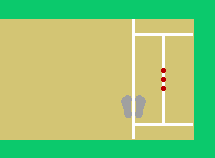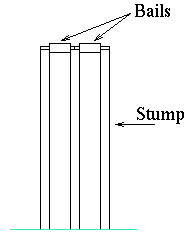The order in which the teams bat is determined by a coin toss. The captain of the side winning the toss may elect to bat or field first.
All eleven players of the fielding team go out to field, two players of the batting team go out to bat. The remainder of the batting team wait off the field for their turn to bat. Each batsman wears protective gear and carries a cricket bat.
The game progresses by the
bowling of
balls. The sequence of events which constitutes a ball follows:
The fielding team disperses around the field, to positions designed to stop runs being scored or to get batsmen out. One fielder is the
bowler. He takes the ball and stands some distance behind one of the wickets (i.e., away from the pitch). Another fielder is the
wicket-keeper, who wears a pair of webbed gloves designed for catching the ball and protective pads covering the shins. He squats behind the opposite wicket. The rest of the fielders have no special equipment - gloves to assist catching the ball are not allowed to anyone but the wicket-keeper.
One batsman stands behind each popping crease, near a wicket. The batsman farthest from the bowler is the
striker, the other is the
non-striker. The striker stands before his wicket, on or near the popping crease, in the batting stance. For a right-handed batsman, the feet are positioned like this:

The batsman stands with his bat held down in front of the wicket, ready to hit the ball, which will be bowled from the other end of the pitch. The batsman usually rests the lower end of the bat on the pitch and then taps the bat on the pitch a few times as "warm-up" backswings.
The non-striker simply stands behind the other popping crease, waiting to run if necessary. The bowler takes a run-up from behind the non-striker's wicket. He passes to one side of the wicket, and when he reaches the non-striker's popping crease he bowls the ball towards the striker, usually bouncing the ball once on the pitch before it reaches the striker. (The bowling action will be described in detail later.)
The striker may then attempt to hit the ball with his bat. If he misses it, the wicket-keeper will catch it and the ball is completed. If he hits it, the two batsmen may score runs (described later). When the runs are completed, the ball is also considered completed. The ball is considered to be in play from the moment the bowler begins his run-up. It remains in play until any of several conditions occur (two common ones were just described), after which it is called
dead. The ball is also dead if it lodges in the striker's clothing or equipment. Once the ball is dead, it is returned to the bowler for the next
delivery (another name for the bowling of a ball). Between deliveries, the batsmen may leave their creases and confer with each other.
When one bowler has completed six balls, that constitutes an
over. A different member of the fielding team is given the ball and bowls the next over - from the opposite end of the pitch. The batsmen do not change ends, so the roles of striker and non-striker swap after each over. Any member of the fielding team may bowl, so long as no bowler delivers two consecutive overs. Once a bowler begins an over, he must complete it, unless injured or suspended during the over.
Another possibility during a ball is that a batsman may get
out. There are ten different methods of being out - these will be described in detail later. If a batsman gets out, the ball is dead immediately, so it is impossible to get the other batsman out during the same ball. The out batsman leaves the field, and the next batsman in the team comes in to bat. The
not out batsman remains on the field. The order in which batsmen come in to bat in an innings is not fixed. The batting order may be changed by the team captain at any time, and the order does not have to be the same in each innings.
When ten batsmen are out, no new batsmen remain to come in, and the innings is completed with one batsman remaining not out. The roles of the teams then swap, and the team which fielded first gets to bat through an innings. When both teams have completed the agreed number of innings, the team which has scored the most runs wins.




